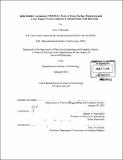High mobility germanium MOSFETs : study of ozone surface passivation and n-type Dopant channel implants combined with ALD dielectrics
Author(s)
Hennessy, John, 1980-
DownloadFull printable version (8.109Mb)
Alternative title
Study of ozone surface passivation and n-type Dopant channel implants combined with ALD dielectrics
Other Contributors
Massachusetts Institute of Technology. Dept. of Electrical Engineering and Computer Science.
Advisor
Dimitri A. Antoniadis.
Terms of use
Metadata
Show full item recordAbstract
Germanium offers higher electron and hole mobility than silicon, making it an attractive option for future high-performance MOSFET applications. To date, Ge p-channel device behavior has shown promise, with many reports of measured hole mobilities exceeding that of Si. However, Ge n-channel devices have shown poor performance due to an asymmetric distribution of interface state density (Dit) that degrades electrostatic behavior and carrier mobility. In this work, two methods are investigated for improving the performance of Ge MOSFETs. First, the formation of an interfacial passivation layer via in-situ ozone oxidation is explored. Long channel Ge p- and n-MOSFETs are fabricated with A12 0 3 and HfO2 gate dielectrics deposited by atomic layer deposition (ALD). The ozone surface passivation is observed to result in significant mobility enhancement for all devices, with particularly dramatic improvement in the n-FETs compared to devices with no passivation layer. Measurements of interface state density show a reduction across the entire Ge bandgap. Further improvement of the interface quality has been observed to occur in the presence of n-type channel implants in Ge n-FETs and this effect is studied. All n-type species investigated in this work (P, As, Sb) are seen to result in significant electron mobility enhancement, particularly at low inversion densities. Ge n-FETs receiving channel implants of As or Sb along with the ozone surface passivation exhibit effective electron mobilities higher than Si electron mobility under some conditions of surface electric field for the first time. Substrate bias measurements and low temperature characterization both suggest a reduction in Dit, primarily of acceptor-like trap states near the conduction band.
Description
Thesis (Ph. D.)--Massachusetts Institute of Technology, Dept. of Electrical Engineering and Computer Science, 2010. Cataloged from PDF version of thesis. Includes bibliographical references (p. 107-111).
Date issued
2010Department
Massachusetts Institute of Technology. Department of Electrical Engineering and Computer SciencePublisher
Massachusetts Institute of Technology
Keywords
Electrical Engineering and Computer Science.